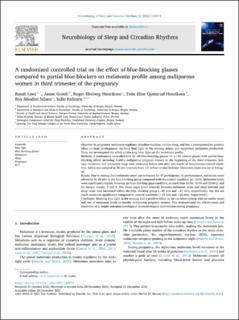| dc.contributor.author | Liset, Randi | |
| dc.contributor.author | Grønli, Janne | |
| dc.contributor.author | Henriksen, Roger Ekeberg | |
| dc.contributor.author | Gjøtterud Henriksen, Tone Elise | |
| dc.contributor.author | Nilsen, Roy Miodini | |
| dc.contributor.author | Pallesen, Ståle | |
| dc.date.accessioned | 2022-02-17T10:46:54Z | |
| dc.date.available | 2022-02-17T10:46:54Z | |
| dc.date.created | 2022-02-02T21:47:50Z | |
| dc.date.issued | 2022 | |
| dc.identifier.citation | Liset, R., Grønli, J., Henriksen, R. E., Henriksen, T. E. G., Nilsen, R. M., & Pallesen, S. (2022). A randomized controlled trial on the effect of blue-blocking glasses compared to partial blue-blockers on melatonin profile among nulliparous women in third trimester of the pregnancy. Neurobiology of Sleep and Circadian Rhythms, 12: 100074. | en_US |
| dc.identifier.issn | 2451-9944 | |
| dc.identifier.uri | https://hdl.handle.net/11250/2979637 | |
| dc.description.abstract | Objective
In pregnancy melatonin regulates circadian rhythms, induce sleep, and has a neuroprotective positive effect on fetal development. Artificial blue light in the evening delays and suppresses melatonin production. Thus, we investigated the effect of blocking blue light on the melatonin profile.
Methods
A randomized controlled trial (n=30 blue-blocking glasses vs. n=30 control glasses with partial blue-blocking effect) including healthy nulliparous pregnant women in the beginning of the third trimester. Salivary melatonin and subjective sleep were measured before and after two weeks of intervention/control condition. Saliva was sampled at 30-min intervals from 3 h before normal bedtime. Melatonin onset was set at 4.0 pg/ml.
Results
Due to missing data melatonin onset was estimated for 47 participants. At posttreatment, melatonin onset advanced by 28 min in the blue-blocking group compared with the control condition (p=.019). Melatonin levels were significantly higher, favoring the blue-blocking glass condition, at clock time 20:00, 21:00 and 22:00 h, and for sample number 3 and 4. The phase angle (time interval) between melatonin onset and sleep bedtime and sleep onset time increased within the blue blocking group (+45 min and +41 min, respectively), but did not reach statistical significance compared to control condition (+13 min and +26 min, respectively).
Conclusion
Blocking blue light in the evening had a positive effect on the circadian system with an earlier onset and rise of melatonin levels in healthy nulliparous pregnant women. This demonstrated the effectiveness and feasibility of a simple non-pharmacological chronobiological intervention during pregnancy. | en_US |
| dc.language.iso | eng | en_US |
| dc.publisher | Elsevier | en_US |
| dc.rights | Navngivelse 4.0 Internasjonal | * |
| dc.rights.uri | http://creativecommons.org/licenses/by/4.0/deed.no | * |
| dc.title | A randomized controlled trial on the effect of blue-blocking glasses compared to partial blue-blockers on melatonin profile among nulliparous women in third trimester of the pregnancy | en_US |
| dc.type | Peer reviewed | en_US |
| dc.type | Journal article | en_US |
| dc.description.version | publishedVersion | en_US |
| dc.rights.holder | © 2021 The Authors. | en_US |
| dc.source.volume | 12 | en_US |
| dc.source.journal | Neurobiology of Sleep and Circadian Rhythms | en_US |
| dc.identifier.doi | 10.1016/j.nbscr.2021.100074 | |
| dc.identifier.cristin | 1997206 | |
| dc.source.articlenumber | 100074 | en_US |
| cristin.ispublished | true | |
| cristin.fulltext | original | |
| cristin.qualitycode | 1 | |

